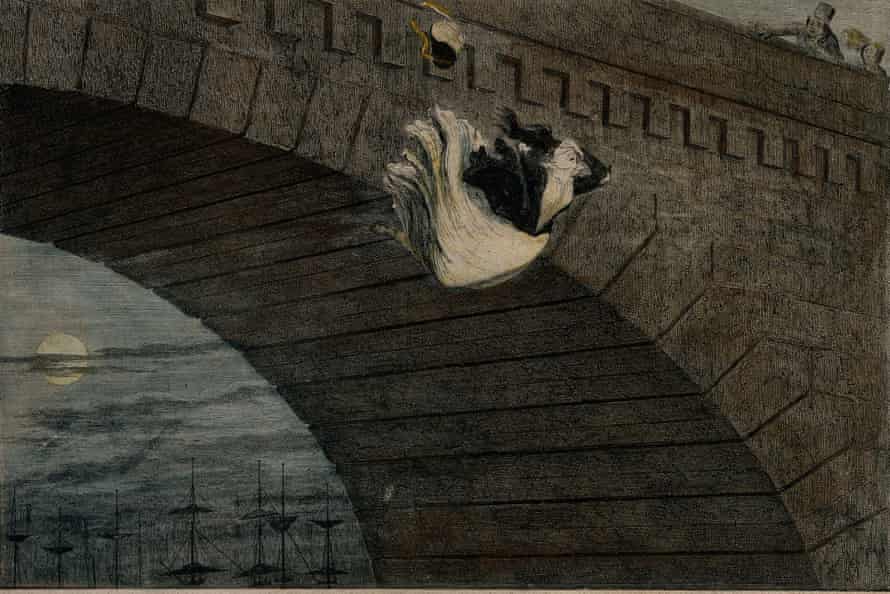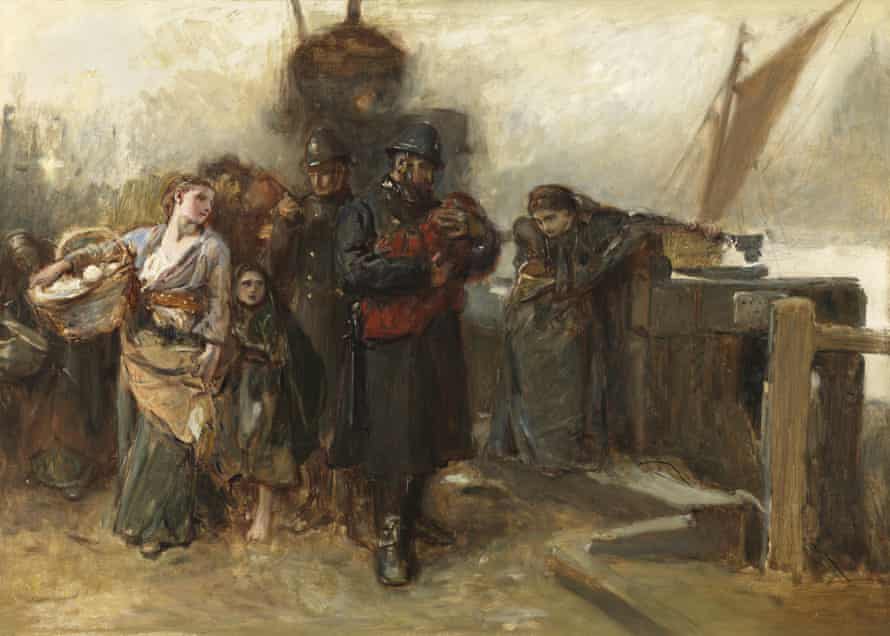What Would Happen to Women Who Left Their Families in the 19th Century
I am surrounded by a fix of paintings produced 150 years ago at the superlative of the Victorian age, and the one thing that stands out is a sense of agony. What is truly shocking and tragic is that they all portray ordinary immature mothers defenseless up in a terrible and unforgiving morality that means abandoning their children is their best, and in many cases their simply, hope for the time to come.
All the images are at the Foundling hospital in London, which, in the middle of the 19th century, took in and raised the babies of "fallen women". Single women who became pregnant had extremely limited choices and, for many, the merely possible route was to give upwards their kid to the Foundling infirmary and then effort to claw their way back to their "respectable" lives as governesses or servants.
Throughout the 19th century, near 4,500 women handed over their children at this infirmary alone. Now a museum, it has held many exhibitions over recent years charting what happened to these babies. But adjacent calendar week, the focus will shift to a story previously untold: the mothers' tales. Who were these women? How did they get into their predicament? And what became of them after they had given up their babies?
They are stories, says Professor Lynda Nead of London'southward Birkbeck College, curator of the exhibition, that have been hard to get together. These women were trying to escape the workhouse (where infant mortality was more than xc%) and gain a measure of respectability; but for both mother and child to survive, they inevitably had to be parted, because no woman could raise a kid born outside marriage and remain in "polite society", or employment, in the 19th century. And so they brought their babies to the hospital.

To become their child accepted, the mothers needed to submit a written petition to prove they were of previous "good character", and that they had only "fallen" into a "criminal conversation", as information technology was euphemistically called, on this one occasion. In front of a panel of middle-anile and elderly men, the young women were forced to describe the details of their sex lives, and their sexual history. Many of the women were illiterate, and so their petitions were written downward by someone else, and these tragic submissions are some other office of the new exhibition.
They were women like 21-year-old Ann Gidding, who in 1831 told the Foundling hospital's governors that she had been a housemaid to Miss Murray of sixteen Wilton Crescent. The kid'south father, she explained, was John Harewood, a footman at the house. After she discovered she was pregnant, he abandoned her; and she had, she explained, no other means whatsoever of supporting her child, imploring the governors to "have this to your feeling consideration".
Susannah Jane Keys, who had recently given nascency to twins, explained that the father of her children was a lodger at the home of friends. He seemed respectable and came to visit her at her father's house, but raped her at that place. She "resisted and cried out", but there was no i to hear.
Harriet Hooper met the father of her kid at a singing class run by a church building organist; he offered to take her to a house where in that location was a piano, so she could sing there; just on arrival it transpired "there was no piano merely a bed. I wished to go out but he prevented me and kept me for some time," she explained. She never saw him once more.
When Annie Culver, a housemaid, became pregnant, the father of her child told her to drown herself, and said he would help her to practice it.
Sarah Farquar, who arrived at the hospital with her child in 1854, was unlike from many, in that she was a governess and so was able to write her ain petition. In a series of messages to the secretarial assistant of the hospital, she describes how she was drugged and and then raped, and that when she later found she was pregnant, "My offset thought was self-devastation and this I attempted twice."
The stories of these women are unlikely to be the whole truth, explains Nead, because in their agony they would try to jump through the hoops the Foundling hospital assembled. "They knew what they had to say to get their baby saved, and it was that they had had been respectable, that they had fallen from virtue, and that they could return to respectability if they could surrender their babies.
"It's very articulate that they feel they have no pick but to give their babies up; and it's very clear that they are aware that this is all about judgment. They were judged right from the very first, in fact: when they came to collect a course from the porter's lodge, the porter would brand notes on their appearance that would afterward be on their file."

Sometimes, though, their petition was rejected. When the infirmary government investigated Ann Gidding'due south story, for example, they discovered there was no Miss Murray at Wilton Crescent, or at Wilton Terrace or Wilton Place either, and her application was turned down.
What happened next to the mothers who were successful in getting the infirmary to take their babies is the hardest thing of all to discover, says Nead. "They melted out of the picture: they were not encouraged to visit their children or to try to continue upward any kind of human relationship with them."
Of the thousands of women who deposited their children at the hospital during the 19th century, but ii ever seem to have been in a position to claim them back, despite the fact that another of the paintings in the show – past the creative person Emma Brownlow, whose begetter was the infirmary's director – is The Foundling Restored to its Mother in 1858.
In a way, the painting is fitting because it illustrates how fable is woven with reality in the story of the fallen women and their babies. At the heart of Victorian England was a myth about women and their virtue, and it is forcefully echoed in the culture of the age: non merely the sort of paintings that are included in the exhibition, but likewise the literature of the times (Lady Dedlock in Charles Dickens' Bleak House and Elizabeth Gaskell's 1853 novel Ruth).
What was essential to Victorian England was that women stayed "pure" (at that place was, unsurprisingly, no parallel narrative of a "fallen human") and what happened to the mothers who arrived with their babies at the Foundling hospital, as played out across the art and literature and music of the century, was to be a lesson to all the rest. The "fault" was all female; and for the women who fell, the driblet was very far indeed.
Source: https://www.theguardian.com/lifeandstyle/2015/sep/19/victorian-women-forced-to-give-up-their-babies-new-exhibition